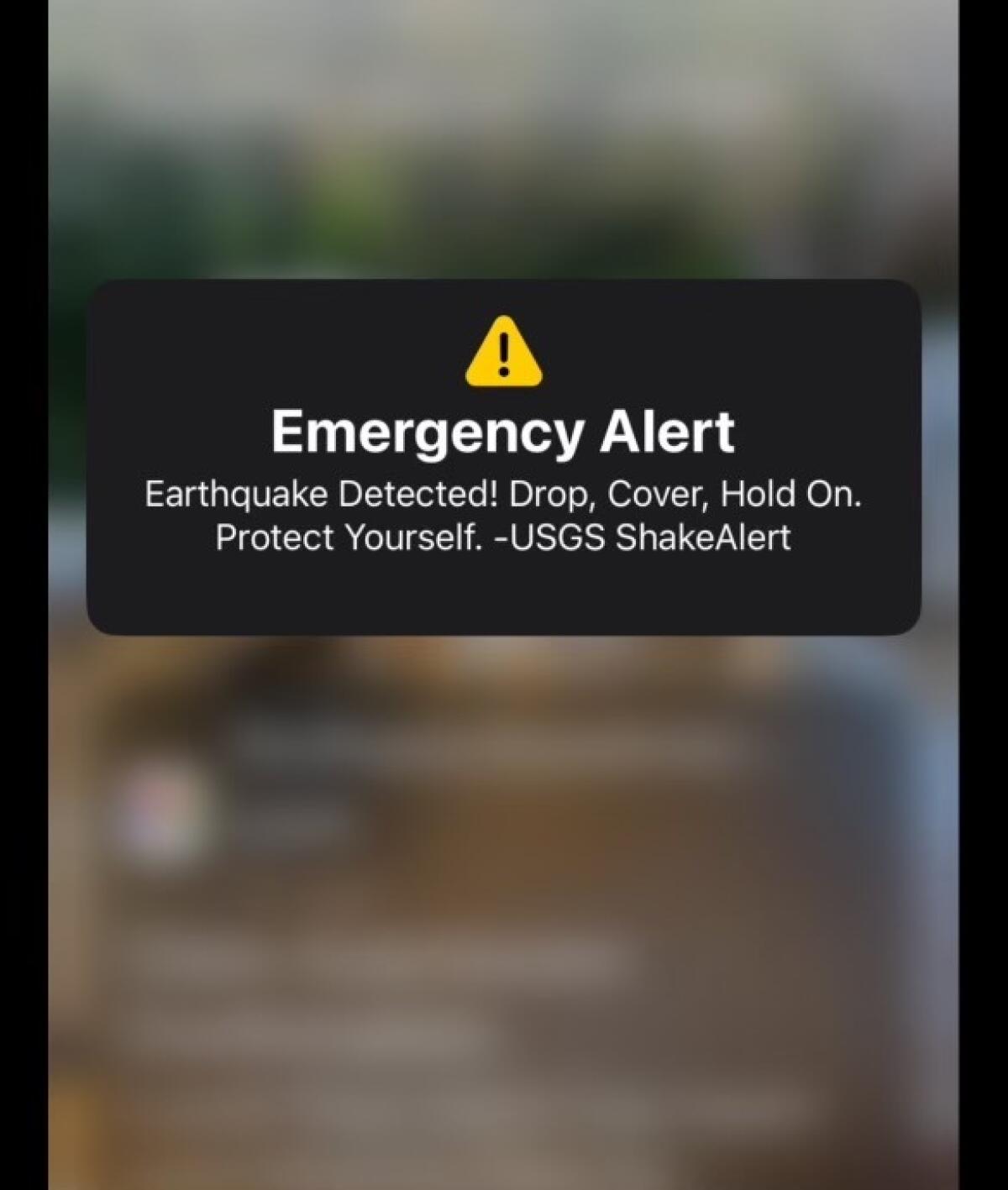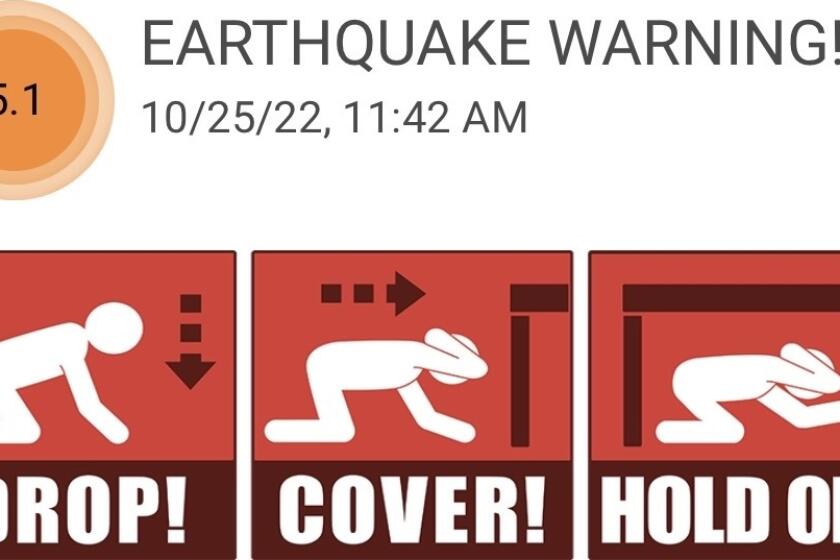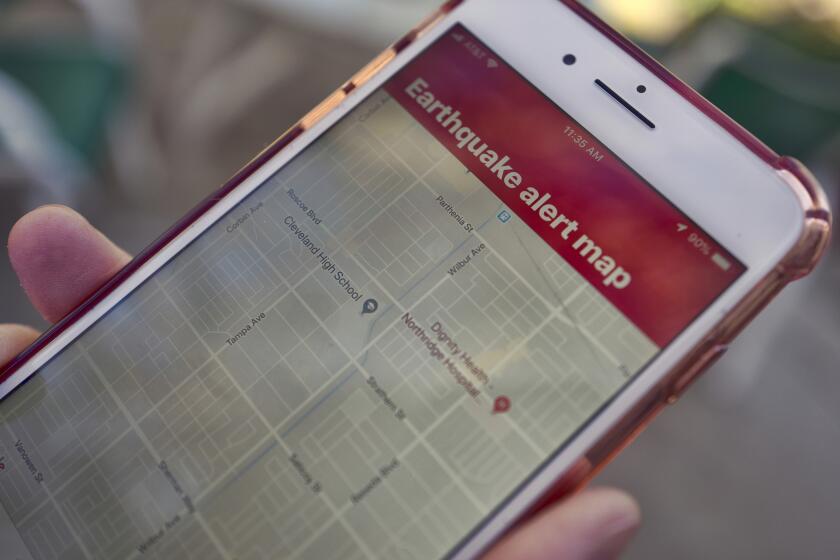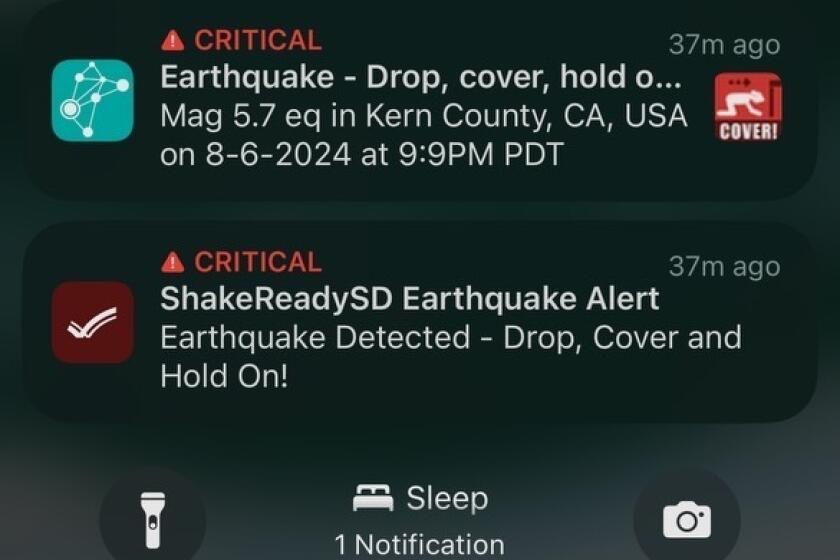‘That was awesome!’ California’s earthquake early warning system let many know about Monday’s temblor

- Share via
Monday’s magnitude 5.2 temblor marked another success for California’s earthquake early warning system, with users in some areas saying they received alerts on their phones before they felt shaking.
The alerts in some cases provided pivotal seconds of lead time — a heads-up that could be crucial in the event of a major earthquake.
“That was awesome! GREAT EARLY WARNING!!!” a resident told the USGS’ ShakeAlert social media account on X. “I got the alert on my phone near downtown San Diego several seconds before the primary [shaking] wave hit. WELL DONE!”
The temblor was centered near the San Diego County mountain town of Julian.
Because shaking from a quake travels at the speed of sound through rock, slower than the speed of modern communications systems, alerts sounded in some parts of Los Angeles before the shaking had even reached the city. No major damage or injuries were reported.

The ShakeAlert earthquake warning system — which is operational in California, Oregon and Washington state — is run by the U.S. Geological Survey. The system relies on a vast array of seismic sensors to detect shaking as soon as it happens. That information is then sent to computers to determine whether and where to send an alert.
People in Camarillo, Manhattan Beach, Palm Springs, Riverside, the San Diego neighborhood of Rancho Peñasquitos, Santa Ana and southern Orange County said they got the earthquake early warning before the shaking started, according to posts on social media and in interviews with local news outlets.
“Corona Del Mar here. Got the alert about 5-10 seconds before a big jolt. Great service,” one resident posted on X.
“I got the alert 1 second before I felt it! I’m in Palm Springs! I’m extremely impressed,” another user added.
Monday’s magnitude 4.4 earthquake — centered near Highland Park — came with an early warning from California’s quake alert system.
“SHAKE ALERT DID IT!! Had phone in hand ... and I had 5+ seconds to respond,” wrote another.
Geologists at the California Geological Survey’s office in Los Angeles also received early warning notifications on their phones “so we were prepared for some shaking,” one scientist posted on social media.
One of the fastest ways people can get earthquake early warnings is by downloading MyShake, a free app developed by UC Berkeley that provides alerts in partnership with the USGS and the California Governor’s Office of Emergency Services. The app can be downloaded to Android devices as well as on iPhones, iPads and Mac computers.
Android phones also have a built-in earthquake early warning app.
More than half a million people in California received early warnings through MyShake on Dec. 5 for a magnitude 7 earthquake that struck 30 miles off the Humboldt County coast; and on Dec. 9 for a magnitude 5.7 earthquake centered about 50 miles southeast of Reno, which was widely felt across Central California.
San Diego County also offers the free SD Emergency app, which includes the ShakeReadySD earthquake early warning tool.
California’s free earthquake early warning app, MyShake, is now available for Mac computers and Chromebooks — a major expansion of access for the warning system.
Some Angelenos who received the alert said it elevated what is typically a fairly normal situation — especially for longtime residents. One person posted on X that she “was, frankly, scared” after getting the “Drop. Cover. Hold on” directions from the alert, though she’s lived through dozens of other quakes.
That feeling, however, can lessen as people become accustomed to the alerts. For some, it’s helpful to know that the shaking they’re feeling is actually an earthquake, so they can take protective actions such as dropping under a desk, covering and holding on.
Earthquake early warnings are now commonplace in seismically active areas around the world, including in Japan, Mexico and Taiwan.
Android phones and those with the MyShake or ShakeReadySD apps installed have the lowest threshold for earthquake early warnings. They’re set to trigger alerts if a quake is estimated at magnitude 4.5 or higher and the intensity of shaking at the phone’s location is expected to be “weak” — defined as Level 3 on the Modified Mercalli Intensity Scale.
Shaking of that intensity would be noticeable to people indoors, especially on the upper floors of a building, and may cause cars to rock slightly. Some people indoors might liken the feeling to vibrations from a passing truck.
More than 5.4 million early-warning phone alerts went out Tuesday for the magnitude 5.2 quake that struck near Bakersfield in Kern County.
People who don’t have smartphones or haven’t installed early warning apps can still receive alerts on their cellphones — but only when a higher magnitude or greater level of shaking is projected at their location. Those alerts are sent through the Wireless Emergency Alert system, similar to Amber Alerts.
One downside to relying on the Wireless Emergency Alerts, however, is that they provide less information than an app-generated alert.
There is a setting you can change on your iPhone to improve the speed, accuracy and reliability of emergency alerts, Apple says. To do that, you can turn on “local awareness” by going to settings, then notifications; scrolling down to “Government Alerts,” then tapping “Emergency Alerts” and navigating to the option.
On its website, MyShake suggests opening the app every month or so to keep it “fresh and ready to receive alerts. Not using the app for a prolonged period might cause the app to be put into deep sleep.”
One easy way to do this, MyShake suggests, is to click on the app when it notifies you — without any urgent, alarming warning sounds — of a significant earthquake somewhere around the world, which typically happens every two weeks. “By tapping on this notification, and opening the MyShake app, you can keep the app fresh, and not have to rely on your own reminders.”
MyShake is now available in six languages: English, Spanish, Tagalog, Korean, Vietnamese and Chinese — the last voiced in Mandarin, and using traditional characters. MyShake will use the first language that it supports from your device’s language and region settings, but on an iPhone you can change the language by going to settings, then apps and selecting MyShake before choosing a preferred language.
Times staff writer Grace Toohey contributed to this report.
More to Read
Sign up for Essential California
The most important California stories and recommendations in your inbox every morning.
You may occasionally receive promotional content from the Los Angeles Times.














